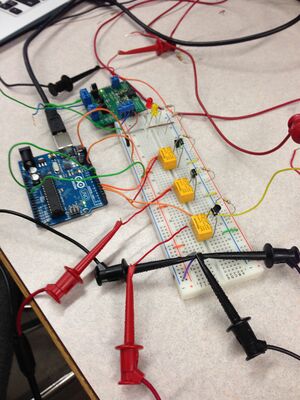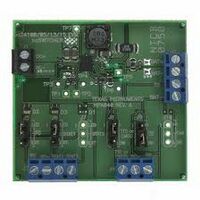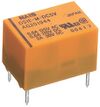Switching LiPo Battery Charger
| Sponsor | |
| Team Name | Trip C |
| Duration | Spring 2014 - Fall 2014 |
| Faculty Instructor | |
| Faculty Advisor | |
| Faculty Mentor | |
| Team Members |
|
The University of Idaho Marching Band has been incorporating multimedia displays into their performances, including synchronized light emitting diodes powered by Lithium-Polymer battery packs. There is a need for a charging system capable of charging approximately 200 packs safely and efficiently within a one week time frame.
Problem Definition
Background
- The Lithium-Ion Battery
| Term | Definition |
|---|---|
| Minimum Capacity | 800mAh |
| Configuration | 3S1P/11.1v/3cell |
| Constant Discharge | 20C |
| Peak Discharge(10sec) | 30C |
| Pack Weight | 75g |
| Pack Size | 57x29x23mm |
| Charge Plug | JST-XH |
A device which can switch between multiple lithium polymer batteries after charge completion of a single battery and hence charges in a sequence is required by the University of Idaho marching band.Automatic switching of the batteries during the charging process requires less user interface and the circuitry to design the aforementioned device is one that can be achieved under a moderate budget. The prototype and the circuitry can be multiplied and extended as the number of batteries to be charged increases and further improvement of the circuit can also reduce costs.
Problem Statement
A robust lithium polymer battery charger that requires less user interface is desired for charging batteries used in the light show produced by the University of Idaho marching band. The prototype required should charge 10 batteries in a day and thus 50 batteries in a week. In future iterations of the project a system containing four of the prototypes modules can be connected in parallel to charge 40 batteries in a day and hence 200 batteries in a week .
Specifications
Marketing specifications:
- 200 batteries need to be charged per week.
- Should be user friendly and require minimum amount of interfacing during or after charging.
- The device should be scalable so that the prototype could be multiplied or added to charge more batteries in future iterations i.e. a modular system.
- The charging status should be indicated to the user.
Engineering Specifications:
- Since 200 batteries needs to be charged per business week, a battery matrix system (charging multiple batteries or charging in sequence through a single board) needs to be formulated. Charging circuit for parallel (simultaneously) or series (charging 1 battery then switching to the next in series) needs to be devised.
- For minimum interfacing, a control system needs to be integrated within the design that controls the voltage and current flow to the batteries. Possible microcontroller programming required.
- The rows and column number of the battery matrix will decide the number of batteries to be charged, parallel or serial charging and the amount of interfacing required. The number of batteries being charged per 2 hrs. (Approx. charging rate for a single battery) or over a course of a day or a week needs to be analyzed to allow the client minimum interfacing but good results.
Design Specifications:
- A battery matrix of 10 X 1 was decided. The design will charge one battery at a time and switch to the next one in the column as soon as the microcontroller senses a voltage change. Hence the design will charge 10 batteries in roughly 20 hours and 40 batteries in the same time if 4 modules of the design are used and connected in parallel to a power supply. Thus, it will charge 200 batteries/business week. This matrix was selected since it will require minimum interfacing from the user as 40 batteries have to be connected once and removed by the end of the day rather than charging 10 batteries in parallel, that will require plugging the batteries in and out after every 2 hours. The single evaluation board circuit (single IC) will be used to charge and will switch to the next battery in the column through a switching circuit consisting of a electromechanical Relay (DS1E) and controlled by a microcontroller.
- Arduino Uno was selected because of it’s small size and a list of important functions (required for the project) that it could implement.
- For charging 200 batteries per week, four of the PCB boards (10 X 1 matrix per board) connected in parallel to a power supply can be used. The whole modular system will charge 40 batteries per day hence 200 batteries per week. A single PCB board will be designed and made while the modular system is left for future senior design teams to finish.
Design
Selections
Evaluation Charging Circuit
The ti bq241xx (bqSWITCHER) evaluation module delivers a suitable technique for evaluating a charging management solution for portable applications. The evaluation module used incorporates the ti bq24105 IC which fulfills the capacity of charging more than three battery cells in series safely and efficiently. The evaluation module for the bq24105 chip is default set to charge one battery cell, but by using the voltage output regulation formula, provided by the integrated circuit's datasheet, one can find the modifiable resistance across two nodes on the module and is able to configure up to three battery cells in series (~12v). By evaluating and observing the module, the constant current and constant voltage characteristics become apparent when testing. First the voltage begins to rise and current is constant. Once the voltage reaches maximum voltage the current decreases to prevent the battery from creating too much pressure inside possibly initiating a fire. Current drops to zero and voltage falls slightly due to charge termination. An occasional topping charge can be applied to top off the charge.
Microcontroller
The Arduino Uno Revison 3 microcontroller board was selected according to desired criteria such as the suitable size, suitable memory, sufficient analog & digital input/output, and large product support. The Arduino Uno R3 is a simple yet robust microcontroller that is based off the Atmega328 processor.
Summary
| Term | Definition |
|---|---|
| Microcontroller | ATmega328 |
| Operating Voltage | 5V |
| Input Voltage (recommended) | 7-12V |
| Input Voltage (limits) | 6-20V |
| Digital I/O Pins | 14 (of which 6 provide PWM output) |
| Analog Input Pins | 6 |
| DC Current per I/O Pin | 40 mA |
| Flash Memory | 32 KB (ATmega328) of which 0.5 KB used by bootloader |
| SRAM | 2 KB (ATmega328) |
| EEPROM | 1 KB (ATmega328) |
| Clock Speed | 16 MHz |
Relay
Panasonic's DS1E-M12V was used for the switching circuit. It's electromechanical nature allowed the battery to be completely electrically isolated from the charging circuit. The specifications of the relay are shown below.
Specifications
| Term | Definition |
|---|---|
| Contact Form | SPDT (1 Form C) |
| Contact Current Rating | 3A |
| Coil Voltage | 12V |
| Maximum Switching Current | 3 A |
| Coil Current | 33.3 mA |
| Coil Type | Non-Latching |
| Power Consumption | 400 mW |
| Termination Style | Solder Pin |
| Contact Rating | 2 A at 30 VDC |
| Mounting Style | Through Hole |
Detailed Design
Design Schematic
Implementation
PCB Design
A PCB was designed that includes the evaluation charging circuit, relays and battery connections. The PCB contains the tibq24115 switcher IC and it's evaluation module (EVM) circuit along with 10 electromechanical relays (DS1E) for 10 batteries. It also has microcontroller connecting junctions along with the EVM junctions for reading the values from the evaluation circuit. The PCB layout is shown below.
Team Information
| Abraham Martinez:
Major: BS in Computer Engineering |
CompE | |
| Pankaj Dhyani:
Major: BS in Electrical Engineering |
EE | |
| Ryler Adams:
Major: BS in Electrical Engineering |
EE |








